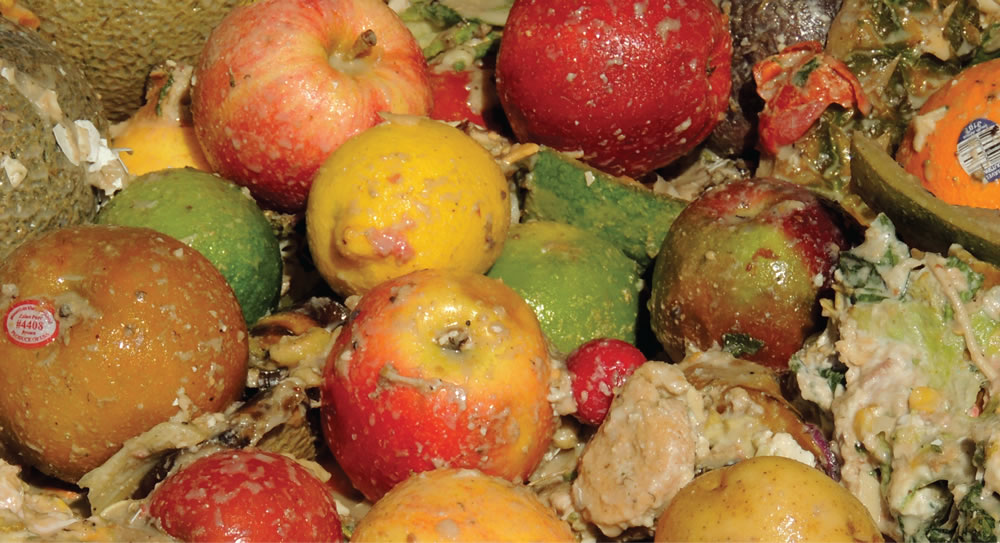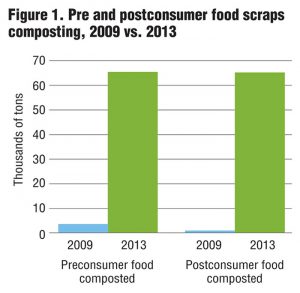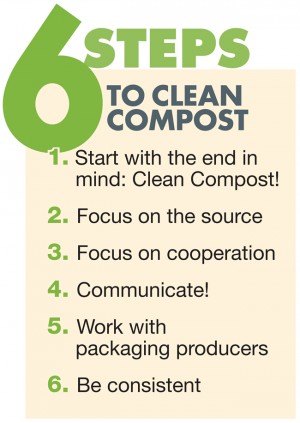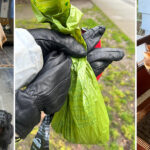The Washington Department of Ecology, local governments and composters are working together to identify reasons behind increasing amounts of physical contamination and ways to reduce it.
Mary Harrington
BioCycle July 2015
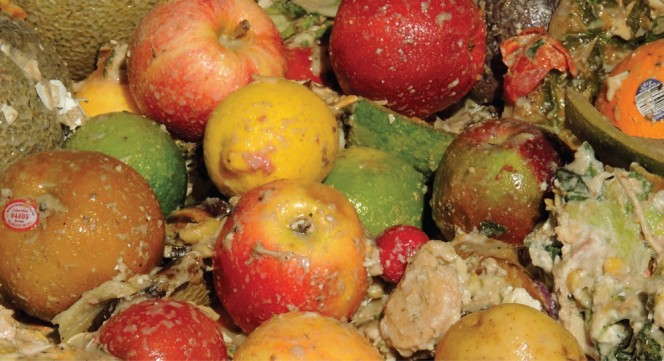
Physical contaminants of most concern to composters are the Big Three: Plastics, glass and produce stickers (above).
Washington State local governments have worked for decades to divert yard trimmings from landfill disposal. By the mid-2000s, many municipalities began to allow for the inclusion of discarded food in their existing yard trimmings collection programs. The practice was encouraged by state and local directives to reduce the amount of material disposed coupled with the high cost of landfilling (especially in Western Washington). Many of these municipal food scraps collection programs began to roll out in 2009 and 2010.
With the advent of the more formalized food scraps collection programs in 2009, composting facilities in Washington State were seeing a significant increase in the amount of material needing to be processed. From 2009 to 2013, the amount of preconsumer food composted rose from about 3,609 tons to about 65,550 tons; the amount of post consumer food composted increased from about 850 tons to about 65,221 tons (Figure 1). Commingled food and yard debris are not included in these composting totals.
Along with all the newly collected food scraps, composters saw a big jump in physical contaminants. The collection programs were effective at getting the organics to the composters, but the composting businesses were seeing too much too fast and the increase in physical contaminants made the finished product difficult to market.
What are the contaminants of concern and where are they coming from? To answer these questions, a group of local government employees, composters and haulers were invited by Washington Department of Ecology staff to discuss the issue. (No private haulers attended the meetings, although local governments with their own collection operations provided collection insights.) This article provides a summary of those discussions.
Contaminators And Contaminants
Meeting attendees had strong opinions about which sector was contributing the most contamination to the collected organics stream. Some laid the blame on the residential sector, some on the commercial sector. Eventually, there was consensus that, regardless of the sector, a few “bad behavers” were responsible for most of the contamination. Staff who managed yard trimmings at transfer stations agreed that self-hauled yard trimmings tended to be fairly free of contamination.
While any noncompostable item is undesirable in collected organics, the physical contaminants of most concern to composters are the Big Three: Plastics, glass and produce stickers. Other contaminants such as shoes, tools, treated wood, balls, wire, and occasionally, the random engine block or kitchen sink, are received and, while annoying, are more easily removed from the feedstock or finished compost. That is not the case with the Big Three.
Plastic tends to be the biggest problem due to its volume and variability. Hard and soft plastic containers, bags in various sizes and colors, and plastic-coated paper products break down into ever smaller pieces while never completely decomposing.
Once mixed with compost, the plastic bits may be almost invisible. However, after the compost is applied, at the first rainfall or irrigation little plastic pieces begin to appear as the compost is ”washed.” Aside from the trashy visual appearance, animals, birds and bugs may mistake the plastic for food and eat it, or the bits could flow into a local water body where fish and other animals could eat them.
Consumers can be confused when reading labels claiming that a plastic product is “compostable,” “biodegradable” or “degradable.” Even if a plastic product truly is compostable, each composting facility has its own timeframe for processing organics, which impacts the rate of disintegration. Whether in the government decision making process or at composting facilities, it’s very important to know the products. If “compostable” items are accepted in the organics collection program or if vendors at public events are required to carry compostable serviceware, make sure to specify compostable products that are accepted at the facility servicing the program. If product bans are implemented on restaurant takeout packaging (such as Styrofoam or polypropylene containers), local governments and composting facilities should identify alternative packaging that is acceptable to the composter so that an unacceptable product is not chosen by the vendor.
Glass is a problem because nobody wants to reach into a beautiful bag or pile of compost and get cut on a shard that made it through the screening process. Also, farmers have voiced concerns that compost containing glass (or hard plastic) applied to root crops could result in the glass or plastic being incorporated into a root vegetable such as a potato. And say the words “produce stickers” to any food composter and you are likely to get a very strong reaction. Produce stickers are small, sturdy, water-resistant and brightly colored. They do not break down in the composting process, typically get through the screening process and act like colorful contamination flags in the finished compost.
Contributors To Contamination
Meeting participants identified a number of reasons for the amount of contamination, reasons that tend to be interrelated:
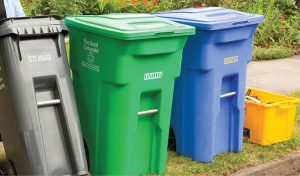
Lack of regional consistency in local governments’ curbside programs, especially in terms of the widely variable list of items accepted in the organics bin, confuses people who live in one community and work in another.
Lack of Program Consistency: The lack of regional consistency within the state was identified as a big contributor to the problem. Every local government has its own program and the widely variable list of items accepted in different programs confuses people. For example, people who work in Seattle but live in Kitsap County think they can put the same items accepted in their work composting bin in their home container (such as compostable servicewares). In the face of this confusion, reducing contamination has become an “end-of-pipe” solution where composting facilities are expected to remove the contaminants from delivered organics.
Collection Complications: In the collection process, every-other-week (EOW) collection, variable can rates, commingling food with yard trimmings, mandatory participation in organics collection programs, and food collection at special events, were seen as potential avenues for increased contamination. When a variable can rate is established, customers receive a large organics container and they usually select a smaller garbage container at a reduced price. Whether a variable can rate is coupled with EOW collection or not, if the garbage container fills before the collection day and the organics container is not full, some participants may be inclined to put garbage into the organics cart. Commingling discarded food with yard trimmings also provides a way for garbage or food in plastic bags or jars to be added to the cart, hidden under the allowed materials.
Participant Push-Back: There will always be some people who react negatively to mandatory participation in any program. The “bad behavers” on the collection route may put garbage into the organics container to spite the mandatory requirement. These behaviors may be difficult to catch or correct, especially given the increased use of automated collection. Although some trucks are equipped with cameras, monitoring for contamination is difficult. As a result, haulers and composting facility operators get only a general idea of who contributed the contaminants, making follow-up messages to the specific offender difficult or nonexistent.
Event and Festival Diversion: Local governments often look to achieve higher diversion numbers by implementing programs at events and festivals. The potential for a high level of diversion is real, but the potential for contamination is very high as well. Capturing a clean organics stream at events is made more difficult by the probable variety of vendor packaging, people from various communities with different programs, and the fast moving nature of the event, all of which can result in collected food scraps contaminated with noncompostable items.
Contract Specifications: Meeting attendees mentioned some other practices that may inadvertently contribute to the contamination problem, such as poorly worded hauler contracts, little or no directions for cart overflow, and little or no direction for how to deal with contaminated loads. Requests for Proposals (RFP) and contracts with haulers and/or composting facilities that don’t reflect local attitudes or legal requirements to reduce contamination can lead to increased contamination at the composting facility. RFPs and contracts must be written and reviewed carefully to be sure they accurately reflect legal requirements as well as local goals and objectives.
Additionally, if the local government or hauler allows for extra organics to be set next to the organics collection container and the contract does not specify how the extra organics should be contained, contamination may result. Finally, the contract should outline how haulers are to manage containers or truckloads with an unacceptable amount of contamination so those loads are not added to less-contaminated material on the tipping floor.
Menu Of Solutions
As the group discussed the possible “how’s and why’s” of contamination in collected organics, a menu of solutions began to surface. The word “menu” is used because governments and haulers can pick and choose from a list of solutions they can afford or that do not require the participation of other partners. Other items on the menu may require regional cooperation or staffing changes that take more work or money to implement.
State And Local Government Actions
The best way to learn about the level of contamination and who might be doing it is to do a Waste Characterization/Composition Study such as the one done in 2014 by Thurston County, Washington (link at biocycle.net). A waste composition study can be done at the state or local level. It can be a large-scale, multiseason comprehensive study done by a hired contractor or as simple as local government staff periodically scanning loads as they are tipped onto the transfer station or composting facility floor. Drivers can identify where the material was collected so seeing what is in the load and knowing where it came from helps make follow-up education more targeted and effective.
As mentioned earlier, local governments must be vigilant with RFPs and contracts to make sure they reflect local goals and legal requirements. Even if no laws exist that define acceptable contamination levels at the curb or in finished compost, local governments working to reduce contamination should reflect that goal in the RFP and contract by specifying a percentage of acceptable contamination in collected organics. The contract also should contain instructions for how the hauler is to manage containers that are overly contaminated.
Meeting attendees stated that haulers are in business to haul and competition for business can be tough, so they are not likely to refuse a load due to contamination — and possibly lose a customer — unless they have a contractual obligation to do so. Contracts can require the hauler to do visual inspections of containers or outline a method for flagging accounts so the company or local government staff can follow-up. Contracts with composting facilities can also include provisions for the facility to flag a contaminated load, accept a contaminated load at a higher price to compensate for additional screening, or reject a load with too much contamination. Financial penalties for contaminated loads may include a caveat that either the hauler or local government will pay a penalty fee for an overly contaminated load as well as any disposal fees if it must be sent to a landfill. Contracts with clearly defined expectations for contamination reduction encourage cooperation and good communication between local governments, haulers, composters and customers.
Dynamic educational programs that target each generating sector (residential, commercial and multifamily) are essential to achieving lower contamination in collected organics. Each sector has its own particular challenges so may require tailored educational messages that address those challenges. If the area population includes people who speak languages other than English, creating educational outreach in multiple languages will facilitate better understanding of the collection requirements. The same holds true for cultural dynamics. Recognizing how different cultures receive or exchange information can improve engagement and understanding of the collection program. For example, some cultures may get more information through peer-to-peer exchanges at churches or community centers and less through on-site web pages. While general educational outreach about reducing contamination is helpful, being able to zero in on identified “bad behaviors” provides the best results.
Along with the variety of materials accepted in different organics collection programs, local governments and state programs use a variety of cart colors for collected material. Local governments, regions and states can help improve proper sorting of garbage, recyclables and organics by standardizing cart colors for the collected materials. Working toward cart color consistency will reduce confusion and contamination. This consistency, along with clearly visible signs and volunteers to answer sorting questions, improves diversion and contamination reduction at special events.
Hauler And Local Government Actions
Haulers and local governments can help reduce contamination by implementing a program to randomly inspect containers. Using volunteers, interns or paid staff to provide periodic inspections of carts is an effective method for identifying sources of contamination. As one local government staff stated, “a picture is worth a thousand words,” so having a camera when doing container inspections is recommended. Providing feedback through brightly colored “OOPS!” tags or stickers placed on the container alerts customers to contamination.
Conversely, encouragement for customers doing the right thing can be achieved with “Well Done!” tags or stickers on the cart. Tracking repeat offenders (either with hand-held computers or written lists) makes it easier for haulers and governments to remove the organics cart from the repeat offender addresses, thus reducing contamination.
To improve participation and reduce contamination from multifamily accounts, the City of Seattle implemented the Friends of Compost monitoring program. Volunteer monitors within the multifamily buildings keep an eye on the carts and provide educational information to residents.
Community engagement was identified as a very important process to improve collection programs and reduce contamination. Government, hauler or composter sponsored peer-to-peer meetings help residents share information with each other and provide valuable information to the local government about the pros and cons of the collection system. Like many other programs across the country, the Seattle multifamily program provides kitchen scrap buckets to participants, a system that has been proven to boost participation and reduce contamination. Some programs include compostable plastic bags to line the bucket, although one local government staff recommended steering clear of scented bags because not everyone likes them.
A community engagement program that has been very successful at raising awareness about removing produce stickers involved cooperation between Snohomish County (WA), Waste Management and Cedar Grove composting. They teamed up to create a produce sticker “bingo” card to remind customers to remove the sticker from fruits and vegetables. The stickers are put on the “bingo” card and when the card is full, customers redeem it to get a free bag of compost.
Processing The Organics
Tracking incoming loads at a transfer station or composting facility is a good first step in reducing cross-contamination of loads at the facility. If possible, have new loads tipped onto a clean floor, separate from previously received material. This provides an opportunity to scan the load for contamination, note the truck number and route if a high level of contamination is found, and remove the most obvious contaminants before adding the organics to the pile waiting to be processed. A local government participant said this process is one of the easiest ways to reduce contamination at the composting facility by making sure many of the contaminants are removed before processing/shredding begins. Manual pick lines and mechanical decontamination such as magnets, blowers and screens are standard methods for removing contamination at composting facilities and can be used to augment contamination reduction initiatives at the curb.
Promoting Compost Use
Finally, once clean finished compost is ready for use, promoting the value of using compost may be necessary. Local governments and composters can overcome ignorance or uncertainty about the benefits of using compost by establishing compost giveaway events like “All you can shovel” or “Fill your truck bed,” or an exchange program like the produce sticker card program. Establishing relationships with community gardens, school gardens and rain gardens provides an opportunity to showcase the benefits of compost while building partnerships and community support. Building relationships with area farmers is also a good way to raise awareness about the benefits of using compost. Farm tours and signs proclaiming use of locally produced compost, made from locally sourced food scraps and yard trimmings, show community members that their efforts to send uncontaminated organics to the local composter is valued and used by community members.
While this article focuses on the impacts of physical contamination on the composting process, contamination negatively impacts all processes designed to convert organics into soil amendments, energy, nutrients or liquid fertilizer. Tips and lessons learned here are applicable to any organics recycling program.
Mary Harrington is the Lead Organics contact for the Washington State Department of Ecology in Lacey, WA. Any questions can be sent to her at mhar461@ecy.wa.gov.


